| |
||||||
|---|---|---|---|---|---|---|
|
1.) Due to precession Polaris was not the Pole star. 2.) The solistices and the equinoxes took place on different days. 3.) Your hint to the symbol on the clay disc on Crete is correct. 4.) I don't think Egyptian influences become visible. Egyptian astronomy was rather poor. (Leitz) The oldest remains are found in Northern Europe (ring ditches, maybe Lascaux). This makes it likely the cultural flow went from the North to the South. This took place about 5000 BC, 2000 years before the pyramids, and 3000 years before the sky disc. 5.) The 25 stars left don't show any constellation with intent. Only the Plejades were shown because they were near the beginning of spring. With best wishes W. Schlosser, Ruhr-Universität Bochum (27.1.2003) |
||||||
|
The astronomy of the sky disc is just a small part of my work. The motive of the sky disc is close to
The Iliad 18, 484-486 and shows us the cultural exchange in ancient Europe which went in both directions. ((483) He made the earth upon it, and the sky, and the sea's water, and the tireless sun, and the moon waxing into her fullness, and on it all the constellations that festoon the heavens, the Pleiades and the Hyades and the strength of Orion and the Bear, whom men give also the name of the Wagon, who turns about in a fixed place and looks at Orion and she alone is never plunged in the wash of the Ocean. (added by the author)) Furthermore some calenderial techniques are shown which were found in ancient cultures from 4600 BC - 1000 AD. But nothing has been decided yet. |
||||||
|
I saw these lines ,too, but they are on the verge of random. With best wishes W. Schlosser, Ruhr-Universität Bochum (28.1.2003) |
||||||
|
It was wrong to use 21.12.1600 BC but
the sky doesn't change abruptly from day to day. The North Star wasn't the Pole star but close to the point where the whole sky was wheeling around. This could be noticed if the sky was watched over some time. The star cluster on the disc doesn't resemble the actual Plejades. Even if the Plejades were important they don't have to be on the disc. Ursa Minor has 7 stars, too. Maybe the star cluster shows the precession. It is doubtful whether Bronze Age people could see stars without interpreting them. People of today don't know constellations. People of that time grew up with gods and pictures in the sky. Just as we can't see the Mona Lisa as spots they probably weren't able to see stars without a meaning. I can't think that someone who placed the Plejades, the sun, the moon and the sicles very exactly adds 25 stars without intent. Why ? Gold was precious. Besides there are the horizontal and vertical lines which certainly had a function. They are at a 90 degree angle. This is very unlikley to be by chance. And if they had a function the others stars didn't have one ? And even if this was so why did the builder chose in the region over the barque this strange pattern which looks like lines but which aren't exact or why didn't he put the stars further apart. If the theory of the Plejades is true why is the bark positioned to the North side of the disc ? It could easily have been placed under the Plejades. If the bark is supposed to be the Milky Way, why does it have lines ? If the symbol is found on Crete and Assyria it seems to have been a fixed meaning. Still symbols can have different meanings in different cultures. If the beginning of astronomy had been 3000 years before Nebra knowledge could have been passed to the South, got reworked there, and passed back and influencing the North again. 3000 years is a long time. The author (14.2.2003) Maybe - just maybe- the sky disc is a cultural mix of the North(usage ,sicles, stars, wheeling point) and the South (bark, stars). This could happen through travellers, traders or immigrants from the South (Crete ?). The stars on the sky disc could be used for navigating, the bark in the South maybe the direction where the people came from or its the bark with the meaning used in Egypt. The author (26.3.2003) |
||||||
|
The copy of my opinion is ok. You and your readers could think about the following : There is a peculiar resemblance between the constellations and younger palaeonlitic inventory of cave paintings. Both are dominated by people/heroes/gods. This is true (100%) for our classical constellations, to my knowledge this is also true for other cultures- though maybe not to this exclusivity. By the way there are hardly any ice age paintings of plants. Only some ornamental-ranking patterns on so-called command wands could be interpreted so. The farmers in the younger stone age would certainly have used beans, spelt, Einkorn and Emmer (old crops) which were very important for their survival. It looks as if the sky and the stars were already used and the constellations already existed. This must have happend during the old stone age then. With best wishes W. Schlosser, Ruhr-Universität Bochum (31.3.2003) |
||||||
|
All the animals shown on the sky have can be admired for something ; they are great, strong, quick etc.
No one admires vegetables. A plant grows well if it gets enough sun and water. But for that someone
else is responsible - a god or something like that. Well, just on first thought. The author (31.3.2003) |
||||||
|
Not bad for a first thought. But if we get to the names of single stars it's not vegetables that are admired but
corn(Spika), the grape(wine-grower - Vindematrix). Later Bonifacius didn't chop cauliflowers but the Donar oak tree.
The Germans didn't silently go into the carrot field but into the woods. These huge trees lead to the Gothic churches
with high columns - just as in Greece. Eyptian columns were resemble bundles of reeds. Christian renaming lead to
"Karlseiche". Plants, everywhere plants...but not in the Old Stone Age and in the sky. With best wishes W. Schlosser, Ruhr-Universität Bochum (01.04.2003) |
||||||
|
Maybe trees were worshipped after gods existed in the imagination of mankind and they represented these gods on earth.
And after agriculture had been invented there was a difference betweens the woods and the open fields. Before
going into the woods had been dangerous which had certainly been not a wise thing to do alone.
Maybe in the Old Stone Age some sort of soul
was attributed to animals because mankind noticed the similarity between them and animals.
At the same time these animals had to be killed to surive and one could be killed by them if one wasn't careful enough.
Maybe the question is why the names of the constellations weren't changed after the enviroment changed and plants
had become important. That would have been easy and today we wouldn't even know that it had been different. The author (01.04.2003) |
||||||
|
To ge back to the sky disc: Something to think about : The sun, the moon -if in full size- and the star cluster resemble Tara (Ireland). They are positioned in the same way. In Tara there are 2 circles in a big one. And there is a tomb which looks to be in the same position as the star cluster. The author (11.04.2003) |
||||||
|
Yesterday there was a report about the Cheops pyramide in TV. It was said that it was build to help the pharao to reach the circumpolar stars after his death through a passage of the celestial pole. This would match to the tomb of Tara and to the sky disc. The author (22.04.2003) |
||||||


Do they look alike? Or is it just a coincidence ? There are certainly some kilometers between them, on the other hand Tara seems to have been a mystical and astronomical place choosen because it has an enormous overview over the landscape and is near to the sky. It would certainly be interessting to have a look at its history. The shafts in the Cheops pyramide point from the king's chamber to the South to the star in the middle of Orion's girdle and to the North to Thuban - then the Pole star. The shaft of the queen's chamber point to Sirius. A boat was given to the Pharao. It was found in the grave. The author (03.05.2003) |
||||||
|
One question is how much astronomical knowledge is really needed
to be a successful farmer.
It looks like people all over Europe and Egypt believed in life after death next to or as stars in the Bronze Age. The celestial pole was maybe the entrance and maybe only at certain days of the year. And - still today we believe in "heaven". If this belief started much earlier this might be the course why there are no constellations named after plants. Plants don't have "souls". Constellations weren't just pictures of the world around. Then they would have been renamed more often. Maybe the owner changed. A clue to that are maybe the small holes. It looks as if the disc was sewn to something. Then the original use of the disc had changed. The author (16.05.2003) |
||||||
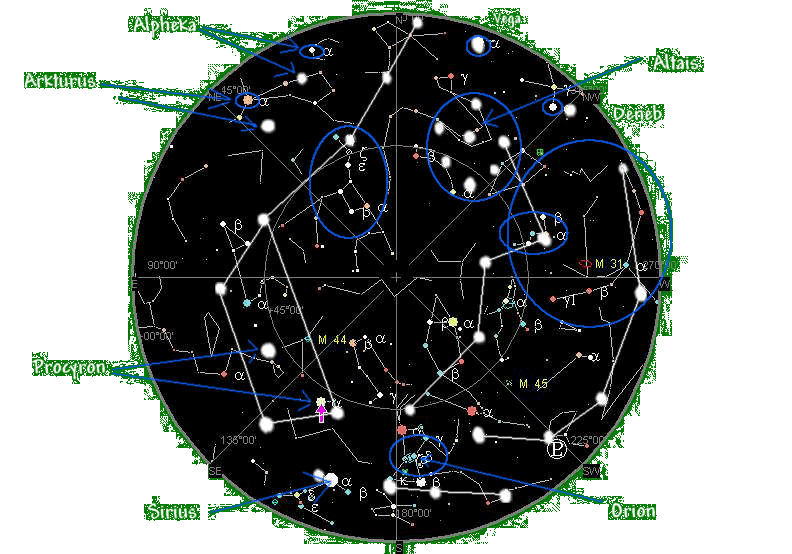 Disc and sky
The constellations are oversized and there is a wrong angle in the Big
Dipper; the rest fits quite well The author (20.5.2003) |
||||||
|
Hello, I was looking for an alternative interpretation of the sky disc and I came across your website. I was irretated by the spontanous interpretation of the seven stars as the Plejades which is logical for a person with a Greek-mythological background, but that couldn't work at that time. If I think of seven stars in the Northern sky I can only think of the Little and the Big Dipper. As two of the stars of the Big Dipper move I think one should take a look at the constellations at that time (Mizar+?). I don't know if Cartes du Ciel can do that. So : - I think the interpretation of the seven stars as the Plejades is unlikely because if one takes the next stars size into account there are 8 stars - How big is the movement of the stars ? - Were there any supernovae or comets at that time ? Gruß Siegfried Kurz (30.6.2003) |
It is very interessting to look at the megalithical culture in Ireland.
On Kerbstone 15 (Knowth) or here there are 7 circle which resemble the Plejades or here . . There are 4 circles in a row, too. Barks or something like that are f.e. on Kerbstone 86 (Knowth) and the Equinox Stone and a ceiling stone(Loughcrew). They can be seen in the lower part. There are four stars in a row on the Equinox stone, too. And there seems to be a kerbstone in Knowth aligned to the south with 3 circles in a row (just like Orion's belt) on it. The author (11.7.2003) |
|||||
|
Loughcrew (about 3000 - 3400 BC),
40 miles north-west from Dublin is situated on 4 hills which lie in a row with a
west-east alignment.
( map )
Most tombs etc. are found on three of them. Maybe these hills weren't only chosen because they are the highest in the area but because they resemble Orion's Belt. Cairn T is on the one in the middle. It's about 40 m wide and on the Equinox days the Equinox Stone ( movie ) is hit by the sun for about 20 min. Let's assume it is a star map. What might it show ? Many symbols are there twice though they are not exactly alike. So they are maybe the same stars on different days or it symbolizes a movement on the Equinox days. The light of the sun moves from the upper left corner to the lower right corner. The sun is rising in the east. The beam moves across the two big "flowers". So let's assume the two big flowers are the sun. I think the bark is Orion's belt - again at two different times. While the sun moves across the stone, the bark moves to the place to meet the sun (Maybe the lines in the second barque symbolize the souls on their journey which arrive at the sun at last - this is the half-circle with the lines above the second flower.). At least on the picture. In reality the sun rises in the east while Orion is setting in the west - the Orion moves away. But maybe this is just a question of explanation. If one takes a look at the religious believes in the ancient Egypt everything starts to make sense. After death it was believed the deceased traveled in a barque into the west into Osiris (= Orion) realm to reach eternal life. In this burial chamber in the end of this journey the deceased appears as a sun disc in the east to show that he or she is born again. Maybe the Equinox days were chosen because life and death are equal to their belief. 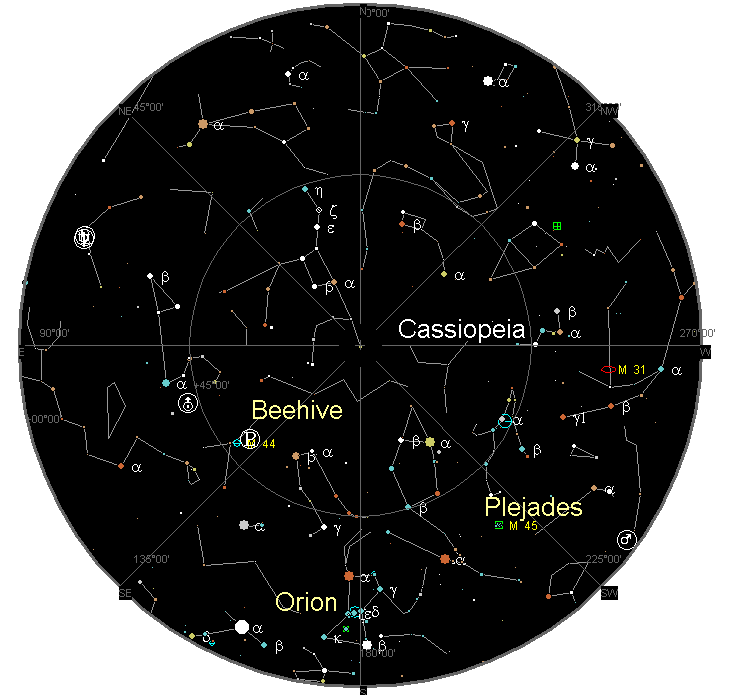
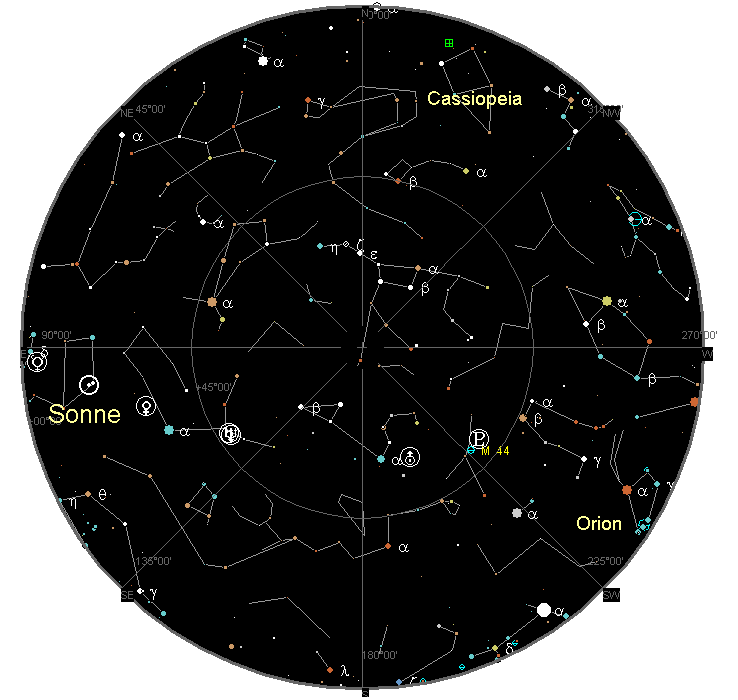
The small flower could be the moon, the three "eggs" star clusters (Beehive, Hyaden, Plejaden) and the "W" Cassiopeia. . The other symbols could be certtain stars (Arcturus, Betageuze). The night sky of the 23.9 at about 4:00 a.m. would even match to the Sky Disc. If Tara and Loughcrew were built on hills with a magnificent view, the question arises why Newgrange, Knowth and Dowth were build near a river and not on hills. Even the latter weren't built at the same time it surprises that their alignment again looks like Orion's Belt - now even with a bark under it. (map) Well, this is just a thought, could be wrong. The author (24.7.2003) |
||||||
|
Why do you think the Disc of Phaistos is a calender ?
Why should pictogram nr. 12 (Evens) be a star cluster ? It has got a symmetrical form.
Apart from that I liked your interpretations. H. Wenzel (You're right. There are several different interprations of the Disc of Phaistos. Here's another one. Maybe the Sky Disk will infuence those interpretations as well.) |
||||||
|
I think it's worth mentioning that on Disc of Phaistos there is a flower in the center of one side and a boat in the second "word" on the other side. There is an open outer ring on both sides and a spiral of signs, sylabels or words leading to or from the center. I think the important part - the end or the beginning- are in the center. The author (02.11.2003) |
||||||
|
Hello, I read an article in a newspaper about the Sky Disc. As I am interested in Astronomy and medieval weapons since 14 (now I'm 52), I'd like tell you my opinion about it from a different viewpoint. I think the 39 or 40 holes on the edge were used to fix the disc on a shield. The disc must have been fixed to a wooden or leather shield. The space between each of the holes is very short like that of a defence shield; so it was tightly fixed. I'm sure that it was a shield which showed the cosmic power of the owner. This would explain why swords and ?Beile were found too. The axes were used for war; they didn't weigh much and could with long handles transport much impact. When the disc was made life was practical, hard and simple. I don't think a valuable piece would have been given into the grave of someone, if it hadn't been for protection. The form of the disc may prove that it was a mystic shield. The carrier of this shield had probably been a well respected person. The things look like those of the greek-turkish region f.e. in the region of Mykonos at about 1600 B.C. . The cooper blades were separetly fied to the blades. This way it was easy to repair or exchange them without exchanging the handles. Bronze is soft and is easily damaged. In the mystic the soul of the sword is in the handle f.e. the Japanese Samurai swords . If a Samurai broke his sword, he was unworthy to live on. The carrier of these swords certainly had a great reputation and contact to the people in the Mediterranen region. The priest were familiar with simple astronomics so that they could do simple prediction. This influenced the maker of the disc. On the back-side of the disc there are traces of hammering. Maybe the result of the fixing to leather. The disc had originally been brown. The stars are not precise and without true knowledge of constellations. The disc was not an instrument of any astronomical measurement. I think it was part of a shield, a sign of power of a powerful warrior which increased after the death of the warrior. I'd like to discuss my theories with you. With best wishes Horst Dieter Döricht (08.12.2003) |
||||||
|
Dear Beate I came across your website regarding the Nebra disc and was intrigued by your theories on its meaning. It all sounds very plausible. Having read a few articles about the disc, it strikes me that none of them refer to the indentations around the edges. Surely these must have some significance? If , as you suggest, the ‘ankles’ refer to winter and summer solstices, and as these are on the edge of the disc, them it may be possible that the indentations at the edges represent parts of a year. I can count 40 indentations around the edge. Could it be that each represents 9 days? If so could this be the week length? The remaining 5 days of the solar year could be attributed to holydays, so making ( 9x40 + 5 = 365). Alternatively it could be 9 months of 40 days + 5. Interesting and possibly plausible. The simple arithmetic may just be co-incidental,but I do remember reading that the Egyptians worked on a 360 day calendar with additional days for their Gods. The idea of indentations around the edge of an object is something that I have also come across in Azerbaijan and which I believe is also calendric in nature. I am attaching a photograph of what I mean. 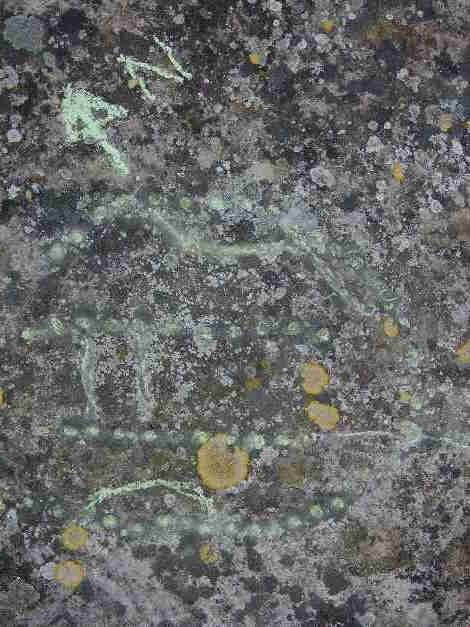
This pictograph above was found on a flat rock next to a megalithic stone circle near Baku, Azerbaijan, so it is pretty ancient. Unfortunately it has not been dated, but might possibly 5000 years. If you look closely you will see 60 dots ( 38 in a horseshoe shape and two lines of 11 dots). Channels interconnect groups of six dots. Green chalk has been used to highlight the indentations. What this all means I am not sure, it could be a child’s game but given that a similar array has been found on a limestone tablet that has been described by a local archaeologists as a ‘calendar’, it does suggest that the more elaborate pictogram above is also a calendar. 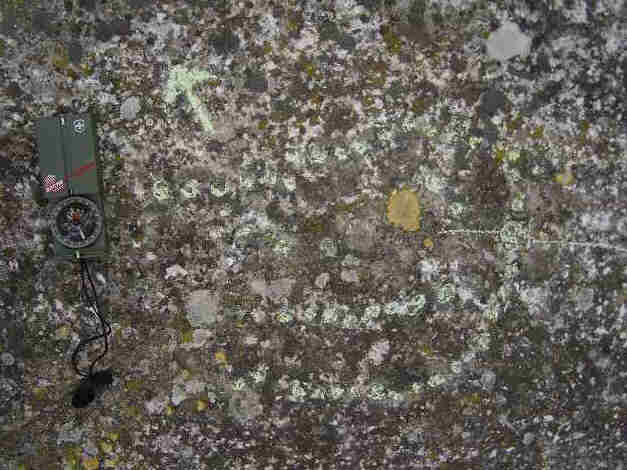
As the ancients were obviously adept at stargazing and monitoring the seasons and years passing it makes sense in many ways for them to use and value calendars. I do believe that both pictures are calendars. I would be interested in your views on both the Nebra disc indentations and of the Azeri ‘calendars’ as day markers. I would also like to know how the calendars worked. (The channels connecting groups of 6 dots are fascinating and cry out for explanation). Any help, ideas you might suggest would be welcome. I wonder too if you know of any ‘experts’ with whom these pictures could be sent to. If they are 5000 years or so old and are calendars then I would imagine someone would be interested in studying them. Best wishes and Merry Christmas Ronnie Gallagher (22.12.2003) |
||||||
|
Please read everything critically as all opinions expressed here are personal.
If you have a different one, tell me !
|
||||||
